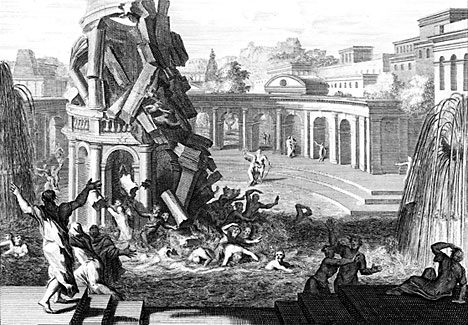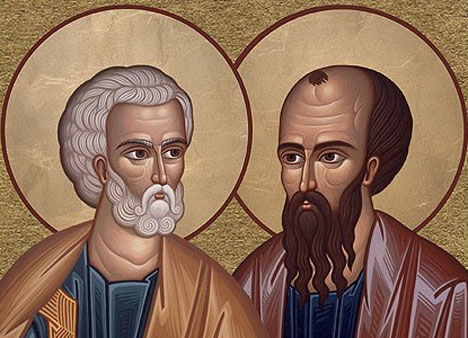Aug
7
2013

Covenant Structure in Zechariah 11
“The meek will eventually inherit the earth but the wicked will always have to buy it.”
Reading the book of Zechariah, like most Bible prophecies, is like tuning in to Season 3 of any good TV series without watching Seasons 1 and 2. Our problem today is not that we haven’t actually read the books of Moses (well, I hope we have) but that we haven’t been taught to read them into the prophets and the New Testament. We treat them like we’ve now switched channels, or shows, and the authors are starting with a blank canvas! However, the canvas isn’t blank. The prophets were God’s repo men, and their messages were all framed in the context of the Covenant contract. What amazes me is how inventive the prophets are (or the Spirit is) in coming up with something new and surprising using the patterns laid down in Moses.
Continue reading
Comments Off | tags: Acts, Esau, Herod, Judas, Literary Structure, Matthew, Minor Prophets, Passover, Pharaoh, Zechariah | posted in Bible Matrix, Biblical Theology
Aug
6
2013
 You Shall Likewise Perish
You Shall Likewise Perish
Peter Leithart has posted a response from Joe Rigney concerning the meaning of Luke 12-13. We had a look at the structure of these chapters here recently (See 666 in the Gospel of Luke), so I thought it would be interesting to see how these two approaches “speak to each other.”
Continue reading
Comments Off | tags: AD70, Joe Rigney, Literary Structure, Luke, Peter Leithart | posted in Bible Matrix, Biblical Theology, Quotes, The Last Days
Aug
2
2013

Paul’s Leviticus
“This is where he picks up the fivefold Covenant structure and turns ‘the right hand of fellowship’ into a set of holy knuckledusters.”
This post has been refined by fire and included in a new book, The Shape of Galatians.
Continue reading
Comments Off | tags: Circumcision, Food laws, Galatians, Hebrews, Leviticus, Literary Structure, Moses, Paul | posted in Bible Matrix, Biblical Theology, Ethics, The Last Days
Jul
29
2013

Paul’s Genesis
It’s time to put another epistle under the matrix-scope!
Continue reading
Comments Off | tags: Covenant curse, Covenant Theology, Feasts, Galatians, Literary Structure, Paul | posted in Bible Matrix, Biblical Theology, The Last Days
Jul
19
2013

“So, perhaps the best conclusion is that John was not looking for encouragement, but giving encouragement. In effect, he was saying, ‘Get on with it, cousin!’”
The nature of the texts of the Bible is just like the spoken words God gave to Adam. A great deal remained unsaid, and Adam was to “read between the lines” based upon God’s revealed character as his Father. However, Adam let somebody else fill in the gaps with some conflicting information about God’s character, somebody who was very likely jealous of Adam’s commission and had an ax to grind (and even here, we are left to fill in the gaps as to Satan’s motive based upon later scriptures!)
Continue reading
7 comments | tags: Albert Garlando, Bible Matrix III, John the Baptist, Literary Structure, Luke, Tabernacle | posted in Bible Matrix, Biblical Theology, Q&A
Jun
29
2013

The Falling Architecture of Luke 12:49 – 13:35
An online friend noticed that the tower of Siloam in Luke 13:4 killed eighteen people, and only a few paragraphs later, in 13:11, the bent-over woman had been disabled for eighteen years. Is this a coincidence? Not likely.
Continue reading
Comments Off | tags: Chiasm, Covenant Theology, Literary Structure, Luke, Steve Jeffery | posted in Bible Matrix, Biblical Theology, The Last Days
Jun
26
2013
 “Smooth narrative” is one of the arguments against the inclusion of the final verses of the Gospel of Mark. The Bible isn’t known for its smooth narrative, anyway, but the ending does seem to pick up the speed suddenly. Is there anything in the text that might point in the other direction? How about literary structure?
“Smooth narrative” is one of the arguments against the inclusion of the final verses of the Gospel of Mark. The Bible isn’t known for its smooth narrative, anyway, but the ending does seem to pick up the speed suddenly. Is there anything in the text that might point in the other direction? How about literary structure?
Mark follows a convention found throughout all the Bible’s texts, based upon the Creation Week and the Levitical Feasts (Leviticus 23). The gospel has a number of “Covenant-shaped” cycles, and the entire book is itself “Covenant-shaped.” This final cycle is left incomplete if the gospel ends at 16:8 (see below). The question is, does this “clockwork” internal textual evidence outweigh the shabby history of the manuscripts? Continue reading
Comments Off | tags: Literary Structure, Mark | posted in Bible Matrix, Biblical Theology, Totus Christus
May
23
2013
 Joe Rigney writes,
Joe Rigney writes,
While Jesus clearly did many signs throughout his ministry (2:23; 6:2; 20:30), most scholars agree that there are seven signs that are emphasized in the Gospel of John, but only six are universally identified.
Continue reading
Comments Off | tags: Joe Rigney, John, Literary Structure | posted in Bible Matrix, Biblical Theology
May
15
2013

“He said to him, ‘Bring me a heifer three years old, a female goat three years old, a ram three years old, a turtledove, and a young pigeon.’ And he brought him all these, cut them in half, and laid each half over against the other. But he did not cut the birds in half. And when birds of prey came down on the carcasses, Abram drove them away.” (Genesis 15:9-11)
When Abram asked for a sign concerning the Lord’s promise concerning an heir, the Lord carried it out with animals slain and displayed upon the Land. In the Covenant-literary structure of Genesis 15, the animals were slain and laid out at “Pass-over,” and the Lord’s chariot (as a Head and Body) “passed-through” at Atonement, (matching Pass-over” chiastically) picturing Joshua and Israel entering Canaan. (See Pass-over and Pass-through, and compare the charts on pages 93 and 115 of Bible Matrix.)
What is also interesting is the “architecture” of the sacrifice. We do not know which animals were considered “clean” by the Lord in Noah’s time, but the number of sacrificial animals was now limited to five. They correspond to the architecture of the Tabernacle. If we include Abram in his deep sleep (as a “covering”) and the birds of prey representing the curse of the Law, in the following diagram we have the complete “footprint” of the humaniform house made entirely out of birds and beasts.
Continue reading
Comments Off | tags: Abraham, Circumcision, Genesis, Literary Structure, Tabernacle | posted in Bible Matrix, Biblical Theology
May
13
2013
 The letters to the pastors of the seven churches in Asia are a prophecy of the history of the Church, according to dispensationalist Bible teachers. For interpreters who are committed to a “literal” hermeneutic, this is bending the rules in the direction of a “literary” hermeneutic, which is excellent. However, they apply the letters to the wrong future, and overlook the obvious allusions to the past.
The letters to the pastors of the seven churches in Asia are a prophecy of the history of the Church, according to dispensationalist Bible teachers. For interpreters who are committed to a “literal” hermeneutic, this is bending the rules in the direction of a “literary” hermeneutic, which is excellent. However, they apply the letters to the wrong future, and overlook the obvious allusions to the past.
Continue reading
2 comments | tags: Dispensationalism, Lampstand, Literary Structure, Revelation | posted in Bible Matrix, Biblical Theology, The Last Days



































